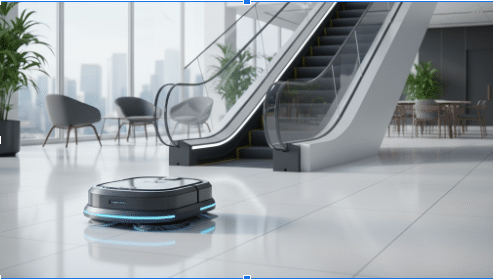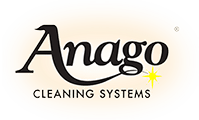
AI cleaning robots, cleanliness sensors, and smart technology are revolutionizing the cleaning industry. We can schedule more efficiently, get real-time data on which rooms need to be cleaned more thoroughly, and even automatically clean floors and windows. The industry has been transformed by AI and robotics. Here’s how:
How AI And Smart Technology Are Revolutionizing Commercial Cleaning
What Is AI Cleaning Technology?
Traditional Methods Vs. AI-Powered Systems
AI Cleaning Robots In Complex Environments
Smart Systems For Monitoring Cleaning Quality
AI Cleaning Robots And Their Impact On Operational Efficiency
Benefits Of AI In The Commercial Cleaning Sector
Improved Cleaning Performance & Quality Control
Enhanced Service Delivery & Customer Satisfaction
Predictive Maintenance For Equipment Longevity
Data-Driven Resource Allocation & Usage Patterns
Cost Implications: AI Vs. Traditional Cleaning
Industry Impact: AI’s Influence On The Cleaning Business
Ethical And Workforce Considerations
Future Trends In AI Cleaning Technology
Why The Cleaning Sector Must Adapt
What Is AI Cleaning Technology?
AI cleaning technology is a broad category, encompassing any technology that uses automation, machine learning, and data analytics to improve processes and automate cleaning. Currently, there are several AI cleaning tools available, including:
- Robotic Cleaners: Robotic floor cleaners can sweep, vacuum, spot scrub, and mop autonomously. These robots detect floor types, cleanliness, and slopes, then automatically adjust their settings and the tools they use to clean floors. Robotic window cleaning robots are also becoming available.
- Automated Scheduling: These software tools use existing data and analytics to determine when a space should be cleaned based on factors like occupancy and staffing.
- Sensors: Sensors use real-time data to help determine when cleaning should be performed. Tools may use people counting, odour monitoring, wetness detection, paper towel levels, and much more.
These tools can be used separately or together to provide a more holistic view of the cleaning needs of a business; as cleaning companies accumulate more data, they can make better, data-driven decisions using AI systems.
Traditional Methods Vs. AI-Powered Systems
We are still far from AI systems performing all cleaning tasks for us. Presently, autonomous cleaning robots are somewhat limited in their capacity; they’re best for maintenance-related tasks, rather than deep cleans. Progress is being made, both on sensors and on design, but we’re still a long way from robotic cleaners replacing humans.
Rather than AI replacing humans, it is augmenting our ability to clean effectively. When robots are cleaning floors and windows regularly, humans can perform more complex cleaning tasks: Getting rid of stains, cleaning bathrooms, and cleaning surfaces that require more care than robots can provide.
AI Cleaning Robots In Complex Environments
The AI cleaning robots used in commercial cleaning are quite different from Roombas or other household cleaning robots. Designed for complex environments, these robots are:
- Robust and durable
- Equipped with several different tools to improve performance
- Designed to automate more tasks; for example, they may automatically empty their bins
These tools allow commercial cleaning robots to operate more effectively in more complex environments than their household cousins. They are durable enough to deal with chemicals and rough surfaces; their tools can help them clean around corners, spot-clean stains, and even work in conjunction with other cleaning robots to improve efficiency.
Smart Systems For Monitoring Cleaning Quality
By using a combination of smart sensors and smart scheduling technology, businesses and cleaning companies can improve operational efficiency.
Cleanliness sensors or smart building sensors are the first part of this process; they’re the eyes and ears that collect data for the scheduling technology. Sensors can collect data about:
- Air quality
- Room temperature
- Occupancy
- Trash bins and recycling
- Dispensers
- Humidity
- Spills
- And more
This data is collected in real-time; it can be used to provide alerts when there are unexpected deviations from the norm, like greater occupancy and spills. Over time, sufficient data will be collected to give businesses a snapshot of a typical day in their building.
This snapshot allows cleaning companies to hone and customize their processes to the businesses they are serving. On a typical Tuesday, a boardroom might go unused, while on a Thursday it’s utilized several times over the course of the day. The cleaning company can use this data to determine that it needs to conduct maintenance cleanings of the boardroom on Tuesdays and more thorough cleanings on Thursdays.
That’s data on a single boardroom; scale it up to the entire building, and it becomes obvious how much more efficiently a building can be cleaned by using data from smart sensors. Scheduling technology will ensure that there are enough staff members to perform deep cleans when necessary: Off-hours, before, or after high-occupancy days.
AI Cleaning Robots And Their Impact On Operational Efficiency
The point of AI cleaning robots is to improve the cleaning process by automating simple tasks, leaving humans to perform more complicated work. As such, AI cleaning robots can have a positive impact on cleaning operations – but only when used properly.
First, staff must be trained to use autonomous cleaning robots. They can perform most work without supervision, but they are not perfect; they can find themselves trapped, debris can get stuck in their tools, and technical issues can arise. When these things occur, it’s important to have trained staff members available to correct the problem so the robot can continue its work.
Fortunately, AI robots typically feature apps, displays, and other tools that make it easy to understand when a problem is occurring, what the problem is, and how it can be fixed. With a little training for human staff, these robots can dramatically improve operational efficiency.
Benefits Of AI In The Commercial Cleaning Sector
Improved Cleaning Performance & Quality Control
The commercial cleaning industry has always been data-driven; the data that was collected, however, was based on a human evaluation of where and when to clean. People have access to schedules, and they can gather all kinds of data through the power of observation; this has informed decision-making in the industry for decades. What should we clean, and when should we clean it? Ask the people who work in the building!
With sensors and scheduling software, commercial cleaning operations can move past the observations made by people and automatically adjust the frequency and type of cleaning performed based on hard data. People still come first, of course, but as occupancy and environments change, we can now adjust our techniques, inform management, and then clean more efficiently.
Outside of sensors, AI-powered cleaning robots also boost cleaning efficiency by automating repetitive tasks, allowing team members to focus on deep cleaning tough areas, refilling dispensers, taking out garbage, and cleaning awkward, hard-to-reach, and sensitive areas.
Enhanced Service Delivery & Customer Satisfaction
The goal of AI-powered cleaning solutions and AI-powered scheduling systems is the same: To improve customer satisfaction by delivering more efficient, more targeted cleaning services. Artificial intelligence allows us to predict when areas will need to be cleaned, to staff appropriately for days where heavier cleaning will be required, and to spot changes in trends before people do.
All of this comes together to create a cleaning service that keeps your space cleaner with fewer resources; it also gives you another way to learn about changes in how your building is being used. We glean insights from the data we get; you can use that same data to get insights of your own.
Predictive Maintenance For Equipment Longevity
This article has been heavily focused on the use of AI for cleaning your business, but we use AI on our own equipment in order to create more accurate preventive maintenance schedules. Preventive maintenance can dramatically reduce the need for repairs; an ounce of prevention is worth a pound of cure, and with the high price tags on repair costs, preventive maintenance on cleaning machines is well worth it.
You can use predictive maintenance software for your own business; facility management systems that include predictive maintenance machine learning can help you better plan your preventive maintenance.
Data-Driven Resource Allocation & Usage Patterns
We’ve talked a lot about cleaning efficiency, but it’s worth talking about cost efficiency too. By using data to allocate resources based on usage patterns, we can ensure that we never have more cleaning staff on a job than we need and that we always have enough staff available on days where more thorough cleaning is required. This dramatically improves our use of resources – and that means lower costs across the board.
Cost Implications: AI Vs. Traditional Cleaning
The lower costs we just discussed aren’t the end of the story. AI cleaning machines and software are expensive, and the software used to allocate resources and provide real-time data requires ongoing subscriptions. Economies of scale are in our favour, here – cleaning companies like ours can subscribe to software to help clean dozens of businesses, while an individual business owner may have to pay a high subscription cost just to clean their own building more efficiently.
For most business owners, the cost of an AI cleaning robot is prohibitive, especially given that these robots still require human supervision. For cleaning companies, on the other hand, the same economies of scale factor in again; if we’re using a cleaning robot for several different businesses over the course of a week, the cost can become well worth it.
Maintenance for these machines is another factor; however, repairs and preventive maintenance tend to be more expensive for robots than they are for traditional cleaning machines, given how complex autonomous cleaning machines are.
Over time, we believe the cost of AI cleaning machines and software will be outweighed by the benefits – but these tools are still relatively new to the industry, so the cost-benefit analysis is not quite clear yet.
Industry Impact: AI’s Influence On The Cleaning Business
The autonomous floor scrubber market is set to grow at a rate of 11.34% until 2032. Robots using software designed by Brain Corp, a company that designs operating systems used by robotic floor cleaners, have operated for over 19 million hours and covered 250 billion square feet of flooring.
This suggests widespread adoption of cleaning robots throughout the industry. Given the forecasted growth of the industry, we suspect the use of AI in commercial cleaning will continue to grow.
Ethical And Workforce Considerations
Leveraging AI should not be considered a means of replacing human labour; instead, it should be looked at as a method of augmenting the work that humans already do. Using AI frees up human labour to perform more complex cleaning tasks; additionally, it allows cleaning companies to make better scheduling decisions.
All of the decisions surrounding AI should put humans first, be they team members or clients. AI should make work more enjoyable and cleaning more effective.
Future Trends In AI Cleaning Technology
As time goes on, we will see designers iterate on existing cleaning robots. New robots may be able to clean more effectively, with less human supervision. We may see robots that can effectively clean walls, much like we’ve seen in recent developments with window cleaning robots. Augmented sensors and better machine learning will also result in better scheduling, more efficient cleaning, and safer, healthier, more beautiful work environments.
Why The Cleaning Sector Must Adapt
AI is here to stay. Robots are automating routine tasks with minimal human intervention; combined with automated scheduling and cleanliness sensors, these new technologies can result in tremendous cost savings.
Cleaning professionals who leverage these technologies may be able to significantly reduce their operational costs while providing more high-quality cleaning to more customers. By adopting AI, cleaning companies like ours can better serve our customers and our team members.
